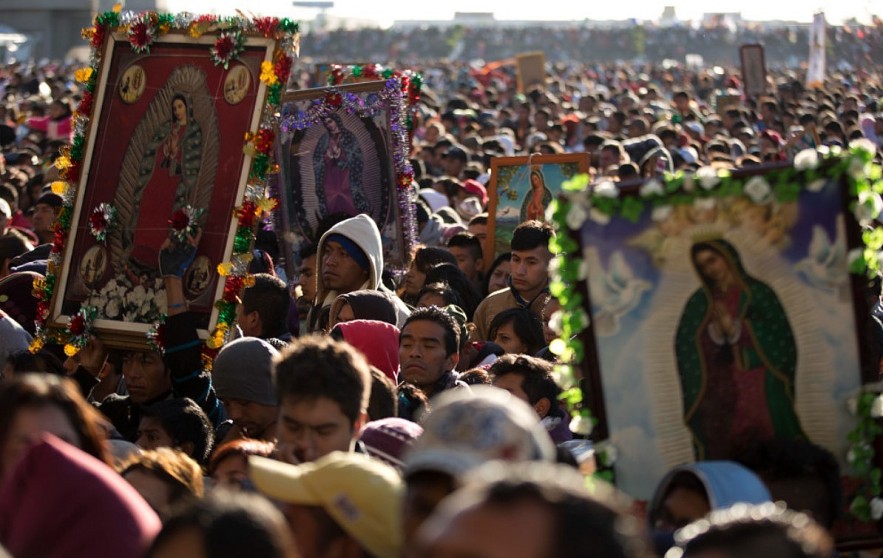Feast of Our Lady of Guadalupe: A Celebration of Faith and Devotion
Dedicated to the Virgin Mary, the mother of Jesus Christ, this feast day commemorates the miraculous appearance of Mary to Juan Diego, an indigenous man in Mexico, in 1531. Over the years, it has become a cherished tradition in many American communities, especially in the southwestern United States, where devotion to Our Lady of Guadalupe runs deep.
Learn more: The Feast of the Immaculate Conception: Celebrating a Sacred Day in the US
 |
| Millions visit Mexico City shrine for Our Lady of Guadalupe's feast day |
The Story Behind the Feast
A miraculous event that took place on December 9, 1531, close to modern-day Mexico City serves as the foundation for the Feast of Our Lady of Guadalupe. According to tradition:
The Apparition: The Virgin Mary appeared to Juan Diego, an Aztec convert to Christianity, on the hill of Tepeyac. She introduced herself as the "Mother of the True God" and asked Juan Diego to request that a shrine be built in her honor.
The Sign: To convince the local bishop of her request, Mary instructed Juan Diego to gather roses—an unusual sight in December—into his cloak, or tilma. When he presented the roses to the bishop, an image of Mary was miraculously imprinted on the fabric.
The image of Our Lady of Guadalupe became a symbol of faith, hope, and unity, playing a crucial role in the conversion of millions of indigenous people to Christianity in the Americas. Today, the tilma is enshrined in the Basilica of Our Lady of Guadalupe in Mexico City, one of the most visited Catholic pilgrimage sites in the world.
The Feast in the United States
Popularity Among American Communities
In the United States, the Feast of Our Lady of Guadalupe has grown in popularity, particularly among Hispanic communities, where devotion to Mary as "La Virgen de Guadalupe" is a cornerstone of cultural and religious identity. This day is celebrated with great enthusiasm in:
- Southwestern states like California, Texas, Arizona, and New Mexico.
- Large urban areas with significant Hispanic populations, such as Los Angeles, Chicago, and New York City.
For many, the feast serves as a reminder of Mary’s role as a loving, protective mother and as a unifying figure who bridges cultural and spiritual traditions.
Traditions and Celebrations
1. Pilgrimages and Processions
- Pilgrimages are a central part of the feast. Devotees often walk to local shrines or churches dedicated to Our Lady of Guadalupe, carrying candles, flowers, and images of the Virgin.
- In cities like Los Angeles, grand processions include traditional Mexican music, dancers, and floats adorned with Marian imagery.
2. Mañanitas
- Mañanitas, or early morning serenades, are a beloved tradition on this day. Worshippers gather at churches before sunrise to sing songs of praise to Our Lady, often accompanied by mariachi bands.
3. Masses and Religious Ceremonies
- Special Masses are held in Catholic churches across the country, featuring readings, hymns, and prayers dedicated to Mary. Many churches also display replicas of the tilma or floral arrangements in honor of the Virgin.
4. Traditional Dances and Performances
- Folk dances, such as the Danza de los Matachines, are performed as acts of devotion and cultural expression.
- Performances often incorporate Aztec elements, reflecting the blending of indigenous and Christian traditions.
5. Feasts and Community Gatherings
- The celebration is incomplete without shared meals featuring traditional Mexican dishes such as tamales, pozole, and atole. These gatherings strengthen community bonds and provide an opportunity to reflect on Mary’s blessings.
The Symbolism of Our Lady of Guadalupe
Our Lady of Guadalupe holds rich symbolic meaning, particularly for Mexican and Latino communities:
Unity: She is often seen as a unifying figure, bringing together people of different backgrounds and cultures.
Advocacy for the Marginalized: The Virgin’s appearance to Juan Diego, a poor indigenous man, emphasizes her love and care for the downtrodden.
Cultural Identity: For many, devotion to Our Lady of Guadalupe is a way of preserving cultural heritage while expressing faith.
Her image, characterized by her brown skin and indigenous features, serves as a powerful reminder of Mary’s accessibility and love for all people, regardless of race or status.
The Feast in Los Angeles: A Vibrant Celebration
Los Angeles, home to one of the largest Hispanic populations in the United States, is particularly known for its elaborate celebrations of the Feast of Our Lady of Guadalupe:
Mass at the Cathedral of Our Lady of the Angels: Thousands gather to attend the special Mass dedicated to the Virgin.
Processions and Performances: Streets come alive with vibrant processions featuring mariachi music, dancers in traditional attire, and floats adorned with roses and Marian symbols.
Community Outreach: The feast also serves as an occasion for charitable efforts, with parishes organizing food drives and other initiatives to help those in need.
The Spiritual Significance
The Feast of Our Lady of Guadalupe is not merely a cultural celebration; it is a deeply spiritual experience that:
Deepens Devotion to Mary: The day invites Christians to reflect on Mary’s role as a compassionate mother and intercessor.
Fosters Faith: By recalling Mary’s miraculous appearance, the feast strengthens believers’ trust in God’s love and providence.
Promotes Gratitude: It provides an opportunity to thank Mary for her guidance and protection in the lives of individuals and communities.
How to Celebrate the Feast of Our Lady of Guadalupe
If you want to participate in this joyous celebration, here are some ways to honor the day:
Attend a Mañanitas or Mass: Join your local parish in early morning prayers and a special Mass.
Offer Flowers and Candles: Visit a Marian shrine or statue to leave flowers and light a candle in honor of the Virgin.
Pray the Rosary: Dedicate your prayers to Our Lady of Guadalupe, meditating on her role in the life of Christ and her love for humanity.
Host a Family Gathering: Prepare traditional Mexican dishes and share the story of Juan Diego and the Virgin Mary with your loved ones.
Learn About the History: Dive deeper into the story and symbolism of Our Lady of Guadalupe through books, documentaries, or talks.
Lessons from Our Lady of Guadalupe
The Feast of Our Lady of Guadalupe offers several powerful lessons:
- Faith and Trust: Like Juan Diego, believers are encouraged to trust in God’s plan, even in difficult circumstances.
- Love and Compassion: Mary’s appearance emphasizes the importance of caring for the marginalized and showing unconditional love.
- Cultural and Spiritual Identity: The Virgin’s image serves as a reminder of the harmonious blending of faith and cultural heritage.
Conclusion
The Feast of Our Lady of Guadalupe is a beautiful and meaningful celebration that honors the Virgin Mary’s role as a mother, protector, and source of inspiration. In the United States, particularly in the southwest, this day brings together faith, culture, and community in a vibrant expression of devotion. Whether through prayers, pilgrimages, or shared meals, the Feast of Our Lady of Guadalupe invites everyone to reflect on Mary’s message of love, unity, and hope, making December 12th a day of both joy and spiritual renewal.
 Dickens on the Strand 2024: Date, Location, How to Visit, Activities and Events Dickens on the Strand 2024: Date, Location, How to Visit, Activities and Events KnowInsiders's guide explores every aspect of Dickens on the Strand, from its rich history to practical tips for attendees, offering a comprehensive look at one ... |
 Las Posadas Festival 2024: Date, Location, How to Visit, Activities and Events Las Posadas Festival 2024: Date, Location, How to Visit, Activities and Events Here is a comprehensive look at the Las Posadas Festival in the U.S for December, its history, significance, and all the details you need to ... |
 Hanukkah 2024: Dates, Locations, Significance, Activities and Events Hanukkah 2024: Dates, Locations, Significance, Activities and Events This guide explores the essence of Hanukkah, the Festival of Lights, its history, customs, activities, and ways to participate in this vibrant holiday. |
 Kwanzaa Festivals: Celebrating African American Culture and Heritage Kwanzaa Festivals: Celebrating African American Culture and Heritage KnowInsiders explores every aspect of Kwanzaa celebrations, from its origins and significance to the activities and events that make it special. |


























